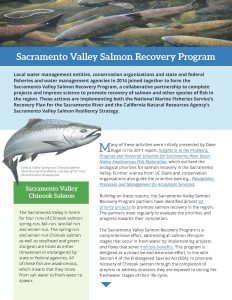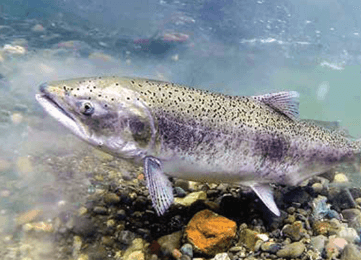The Voluntary Agreements that have been developed in the Sacramento River Basin are providing new opportunities to bring together and catalyze priority projects to improve conditions for salmon. This is a positive step forward for California. These projects have all been proposed by expert biologists and then further developed by water resources managers. These efforts are part of and will further implement the Sacramento Valley Salmon Recovery Program (Recovery Program), which has been a centralized effort to prioritize projects, and, most important, to manage, coordinate and advance projects through completion. The Recovery Program in turn is helping implement the California Natural Resources Agency’s Sacramento Valley Salmon Resiliency Strategy, the National Marine Fisheries Service’s Chinook Salmon Recovery Plan, and salmon recovery efforts contained in the Bureau of Reclamation and Fish and Wildlife Service’s Central Valley Project Improvement Act programs.
 The Recovery Program has established a reputation for completing long-languishing salmon projects, including seventeen in the last four years, that are addressing the weak links in the salmon life-cycle. The priority projects developed as part of the Voluntary Agreement process (see A10 in link) are designed to improve conditions for salmon and substantially contribute to the achievement of the environmental targets included in the Natural Resources Agency March 1st submittal to the SWRCB.
The Recovery Program has established a reputation for completing long-languishing salmon projects, including seventeen in the last four years, that are addressing the weak links in the salmon life-cycle. The priority projects developed as part of the Voluntary Agreement process (see A10 in link) are designed to improve conditions for salmon and substantially contribute to the achievement of the environmental targets included in the Natural Resources Agency March 1st submittal to the SWRCB.
Bringing together these various programs to further prioritize projects for the Voluntary Agreements has created an exciting opportunity to integrate these projects with the timing of flows on the different rivers to more effectively improve conditions for fish and wildlife. The Voluntary Agreements will catalyze these projects as follows:
- The Voluntary Agreements are providing an opportunity to further develop and learn from new science regarding the important role floodplains play in providing substantial quantities of habitat and food for out-migrating juvenile salmon, which they are not currently receiving in the river channels.
- The projects will all be integrated with functional flows that are designed to benefit all fresh water life-cycle stages for Sacramento Valley salmon in a comprehensive manner. This builds upon and supports the latest science in the local, state and federal recovery efforts.
- The various independent local, state and federal prioritization processes for salmon habitat that have come together in the Voluntary Agreement process have identified many of the same priority projects. This suggests that these projects are projected to provide the greatest likelihood to promote Chinook salmon recovery. It will hopefully result in projects that have been languishing for years as plans or concepts actually receiving implementation funding, permits and project management to facilitate their completion.
- As shown in the last column of the projects in Appendix A10 described above, most of these projects are not required to be completed. Despite being identified as a priority through these various processes (in some cases, for years, if not decades), it does not indicate an obligation, commitment or guarantee that the project will be completed. The projects will only be completed through the work of local agencies, with support from state and federal agencies and conservation organizations as seen in the Voluntary Agreement process. In other words, identifying a project as a priority does not equal a commitment to its completion, without the Voluntary Agreements to catalyze these efforts toward completion.
- The Voluntary Agreements will facilitate the implementation of projects that for various reasons were initiated but never completed. This includes the scaling-up or construction of a complete project that previously was a pilot project and the construction of projects that earlier received funding for planning and/or design but were never funded for construction.
- The Voluntary Agreements will also lead to the completion of individual projects that are components of larger efforts that may have received funding for other work, such as the various projects proposed to improve habitat and fish passage in the Yolo Bypass.

In the Sacramento River Basin, the Voluntary Agreement process is creating an exciting opportunity to build upon previous prioritization efforts and advance the Sacramento Valley Salmon Recovery Program through the implementation of salmon habitat projects and flows to address all fresh water life-cycle stages of Chinook salmon. Many of the projects included in these lists are long-standing, agreed-upon priority projects that, with this program, may finally receive the support and funding needed to be implemented.



